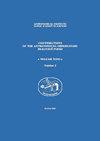上层主序星的光球硅丰度由Si II 6347/6371重线得出
IF 0.2
4区 物理与天体物理
Q4 ASTRONOMY & ASTROPHYSICS
Contributions of the Astronomical Observatory Skalnate Pleso
Pub Date : 2021-10-23
DOI:10.31577/caosp.2022.52.1.5
引用次数: 0
摘要
这项研究的目的是确定双星TU UMi的日食时间。极小值的时间取自文献、我们2004年4月的观测结果以及2019年至2022年的TESS观测结果。系统的轨道周期分析表明,存在振幅为0.0081d、周期为9.03年的周期振荡,并以$dP/dt=-1.12乘以10^{-7}、\mathrm{d}、\ mathrm{yr}^{-1}$的速率连续下降。我们研究了系统轨道周期的长期演化,以及系统中存在第三个伴星或主要成分磁活动周期的可能性。本文章由计算机程序翻译,如有差异,请以英文原文为准。
Photospheric silicon abundances of upper main-sequence stars derived from Si II 6347/6371 doublet lines
This study aims at timing the eclipses of the binary star TU UMi. The times of minima are taken from the literature, from our observations in April 2004 and from TESS observations between 2019 and 2022. The orbital period analysis of the system indicates that there is a cyclic oscillation with an amplitude of 0.0081d and a period of 9.03 yr, accompanied by a continuous decrease at a rate of $dP/dt =-1.12 \times 10^{-7}\,\mathrm{d}\, \mathrm{yr}^{-1}$. We study the secular evolution of the orbital period of the system and the possibility of the existence of a third companion or the magnetic activity cycle of the primary component in the system.
求助全文
通过发布文献求助,成功后即可免费获取论文全文。
去求助
来源期刊
CiteScore
1.10
自引率
20.00%
发文量
4
审稿时长
>12 weeks
期刊介绍:
Contributions of the Astronomical Observatory Skalnate Pleso" (CAOSP) is published by the Astronomical Institute of the Slovak Academy of Sciences (SAS). The journal publishes new results of astronomical and astrophysical research, preferentially covering the fields of Interplanetary Matter, Stellar Astrophysics and Solar Physics. We publish regular papers, expert comments and review contributions.

 求助内容:
求助内容: 应助结果提醒方式:
应助结果提醒方式:


